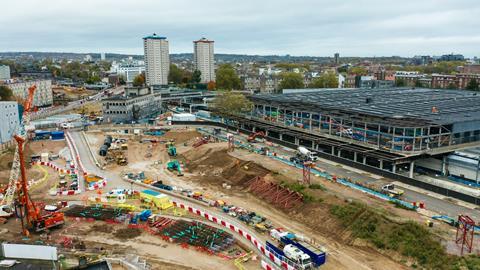Industry shows ÔÇśresilienceÔÇÖ with third consecutive month of expansion
Construction output rose slightly in September despite an overall fall in UK gross domestic product (GDP).
The industryÔÇÖs output rose 0.4% according to the Office for National Statistics, the third consecutive monthly of growth for the sector as the country heads towards recession.

Construction was the odd one out of the UKÔÇÖs major sectors, with services stagnating and manufacturing down 2.3%.
The 0.6% fall in GDP seen across the economy in September was sharper than the 0.1% fall of the prior month.
The Bank of England recently estimated that the third quarter saw the UK enter a recession that could last until mid-2024.
The growth in constructionÔÇÖs output rate was slightly slower than the (upwardly revised) 0.6% recorded for August, and was driven mainly by infrastructure and public housing repair and maintenance, which increased 2.8% and 11.3% respectively.
According to anecdotal evidence from the monthly business survey for construction and allied trades, the cost of living crisis continues to be a major factor in the decline of private housing repair and maintenance, for which output dropped 1.1% in September.
Simon Rawlinson, Arcadis, said the figures were a sign that demand ÔÇťremained resilient right up until the turmoil of September 2022ÔÇŁ and that this was ÔÇťa good foundation for the industry to enter a slowdownÔÇŁ.
ÔÇťMarkets will undoubtedly slowdown but a strong 2022 has at least provided a solid cushion of workload,ÔÇŁ he said.
David Savage, head of construction at Charles Russell Speechlys noted that this was a ÔÇťbackwards facing viewÔÇŁ and that it remained to be seen how the sector reacted to the ÔÇťpolitical turmoilÔÇŁ triggered by Liz TrussÔÇÖ mini-budget and subsequent resignation.
>> Market forecast: Upward but uneven
>> Latest trends and prices data dashboard
McBains managing director Clive Docwra said the sector was continuing to ÔÇťdemonstrate resilienceÔÇŁ in the face of economic challenges.
ÔÇťOrder books currently remain strong in many work sectors, and the 5% increase in new orders in private commercial work is a sign that confidence is still in evidence,ÔÇŁ he said.
He added that the industry nonetheless faced ÔÇťa rocky road aheadÔÇŁ and said that with projects likely to be curtailed due to falling confidence, ÔÇťa major risk is that crucial efforts to decarbonise building stock could be sidelinedÔÇŁ.
ÔÇťThe government could help by giving the green light to a retrofitting programme, which will not only support the industry but help keep net zero targets on track,ÔÇŁ he said.


























No comments yet